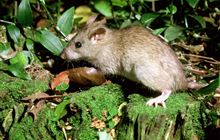It’s a wrap for rats on Cook Islands atoll
Introduction
A rat eradication operation has wrapped up on Cook Islands’ Palmerston Atoll (500km from Rarotonga), with the hope that introduced rats never return to menace the atoll’s community and ecosystems.Date: 28 November 2023
“This rat eradication has been a long time coming,” Palmerston’s Executive Officer Arthur Neale says.
“Rats have been a problem on this atoll for over a century – destroying wildlife and eating crops – and the problem could become even worse by making us less resilient to climate change impacts.”
Arthur says the Palmerston community took the initiative and requested, with the support of Cook Island Government agencies and Non-Government Organisations (NGOs), a survey of natural resources on the island.
“The survey proved that our rat situation was grim. But there was an exciting key finding in the report – we could eradicate rats from our atoll and hopefully seabirds and other wildlife would return.”
From there, a partnership to eradicate introduced ship rats (Rattus rattus) and Pacific rats (Rattus exulans) from Palmerston was set up between the New Zealand’s Department of Conservation (DOC), the Palmerston Atoll community, the Cook Island’s National Environment Service and Ministry of Agriculture, and the local NGO, Te Ipukarea Society.
Following consultation with Palmerston’s community and a feasibility study in 2022, the eradication operation kicked off in mid-August 2023. The work took six weeks, covering Palmerston Atoll’s Home Islet, which has around 30 inhabitants, and the uninhabited Cooks Islet. Four and a half tonnes of rat bait was distributed across 70 hectares in three applications.
Arthur Neale says the community did a lot of preparation to ensure the success of the operation.
“We couldn’t have any food available for the rats – the bait had to be the only option for rats to eat. Households had to ensure their kitchen wastewater drainage systems were completely sealed. Most of us had to completely renew our kitchen wastewater drainage system.
“Some of us cleared bush areas, removed sugar cane from our gardens and removed any fruits from fruit trees and stopped growing vegetables known to be eaten by rats, such as cucumbers.
“Freezers were used for food storage. People had to put their food scraps in sealed containers. Household rubbish was placed in covered sealed bins for weekly collection to be incinerated by the Island Administration staff.
“We had to cull some of our livestock chickens and pigs as they might eat the toxic bait. Some households moved some of their livestock to other islets where they were penned. Contained sealed food scraps were collected for feed for chickens and pigs on the islets.”
DOC’s Em Oyston was the project team leader and one of three DOC National Eradication Team members on the ground for the operation. The team has international expertise in island eradications and works for New Zealand’s Predator Free 2050 Programme.
“Everyone on the atoll was part of the team and had a role to play for the eradication to work. We were thorough and worked together because even a single female rat left alive could mean failure for the whole operation,” Em says.
Tropical environments like Palmerston Atoll can have over 200 rats per hectare as they breed year-round in warmer, more productive environments.
Three applications of bait were spread by hand across the two islets to achieve comprehensive coverage. This equated to more than 2220 baiting points on the ground.
In addition, over 116 buildings on Home Islet (from sheds to family homes and municipal buildings) were baited with at least one bait tray in every room, plus baiting underfloor and in the ceiling cavity.
Ensuring no rodents arrive on vessels or cargo is key to the long-term success of the project.
Arthur Neale says: “Even though the operation is over, the work to keep rats off the atoll has just started. This will require working with vessels from Rarotonga that come with people, food supplies and other cargo. We’ll check vessels offshore for rats and any other pest that threatens our biosecurity.”
The biosecurity infrastructure has been installed, including detection devices and traps in case a rodent makes it onto land. If a rodent is detected, DNA samples of the original population are held to assess if it was a survivor of the eradication attempt or a new arrival.
The Cook Islands’ National Environment Service (NES) Biodiversity Coordinator Jessie Nicholson says NES is proud of the hard work and sacrifice each community member in Palmerston made to ensure a successful rat eradication.
“This operation has pioneered the way for future rat eradications on inhabited islands in the Cook Islands. We thank those involved in the project, since its inception, to turn this vision of a rat-free Palmerston into a reality.”
The community have been monitoring for the presence of rats since the field team departed. Project partners will assess the operation’s results in April 2024 to determine whether the island can be officially declared rat free.
Background information
This work is funded by the New Zealand Ministry of Foreign Affairs and Trade (MFAT) and is delivered through the Pacific Regional Invasive Species Management Support Service (PRISMSS).
The New Zealand Department of Conservation, the Secretariat of the Pacific Regional Environment Programme (SPREP), and Manaaki Whenua have joined forces to support Pacific Island Countries and Territories to build resilience to climate change by taking stronger action against invasive species.
Contact
For media enquiries contact:
Email: media@doc.govt.nz

